Offer sheets have a certain kind of stigma when it comes to the NHL and its offseason. They don’t happen very often, and when they do, they’re usually matched immediately. This summer has been unlike recent ones as there are plenty of big-name restricted free agents (RFA) who remained unsigned and eligible to receive one.
We already saw the Montreal Canadiens give it a go when they signed Sebastian Aho of the Carolina Hurricanes. Not every team can pull it off, but the New Jersey Devils are one of the few that have the means.
Is it something general manager Ray Shero should consider?
NHL Offer Sheet Compensation
Before getting into which RFAs should interest Shero, let’s go over what he’d have to give up if they sign someone to an offer sheet. It ranges from giving up nothing at all (anything below $1,395,053), to as much as four first-round picks (anything above $10,568,589). Here’s the full break down:
It’s important to note that a team must have all their own draft picks, and they cannot use another team’s picks acquired in a trade. The player also has to agree to the signing. Teams can’t just go sign whichever RFA they feel like because it’s a player’s right to reject them. You also need cap space if you’re going to go after a big name like Mitch Marner. So without further ado, let’s see who they could target.
Patrik Laine
Laine is one of the top RFAs available. He’s coming off a 30-goal, 50-point season with the Winnipeg Jets, which is a 20-point drop from 2017-18. His dip in production isn’t a case of bad luck, either, as his underlying numbers were among some of the worst on the team.
He finished with a Corsi-For percentage (CF%) of 45% and an expected goals for percentage (xGF%) of 42% at five-on-five. His goals above replacement (GAR), which shows how many goals he adds to his team relative to a replacement-level player, was 1.4. Those numbers are signs of a troublesome trend, too.
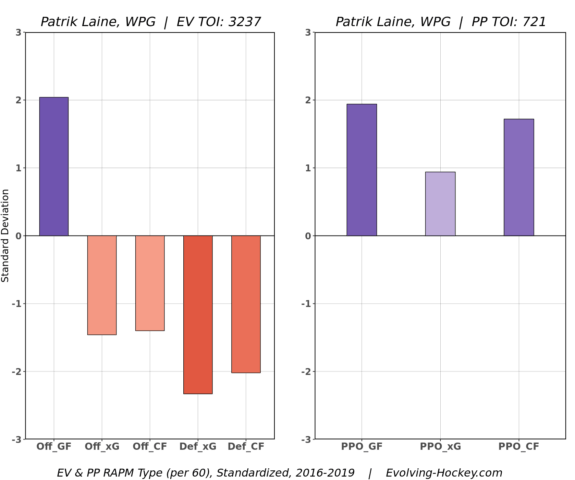
He has a positive impact on scoring goals, but he’s severely outperforming his offensive expected goals (Off_xG) at even strength (EV). He’s also a liability on defense as opposing teams tend to generate a ton of shot attempts (Def_CF) and defensive xG when he’s on the ice. He does perform well on the power play, so that helps make up for his EV struggles a bit. But that’s not a trend you like to see moving forward.
Laine said he dealt with back problems in 2018-19, which explains part of his struggles. But there are definitely concerns about his overall play. The truth is it’s tough to see where Laine will be three to five years from now. He’s a good player, but I’d wary be of pursuing this route to acquire him.
Related: Devils Should Pursue Unsigned Gardiner
Evolving Wild’s contract projections have him earning over $7 million annually over seven years, and it’s possible he could get more. If he wants anything over $8,454,872, the Devils would have to give up two first-round picks as well as a second and third. They don’t have their own second-round pick after acquiring P.K. Subban, so this may end being a moot point. And it’s probably for the best as there’s too much risk for a player who has a fair number of question marks.
Mitch Marner
Marner has been the talk of this RFA class. He’s coming off a breakout campaign with the Toronto Maple Leafs, where he finished with 94 points in 82 games, a 25-point jump from 2017-18. It’s been rumored he’s looking for a payday similar to his teammate, Auston Matthews, whose annual salary is $11.6 million. But is he worth it?
Marner has averaged 2.47 points per 60 minutes (P/60) since the start of last season, while Matthews has averaged 2.83. Marner’s GAR is 30, while Matthews is 28.2. The two players have similar on-ice stats, but Matthews has a more positive impact on offense than Marner. With that said, Matthews’ defensive game leaves a lot be desired.
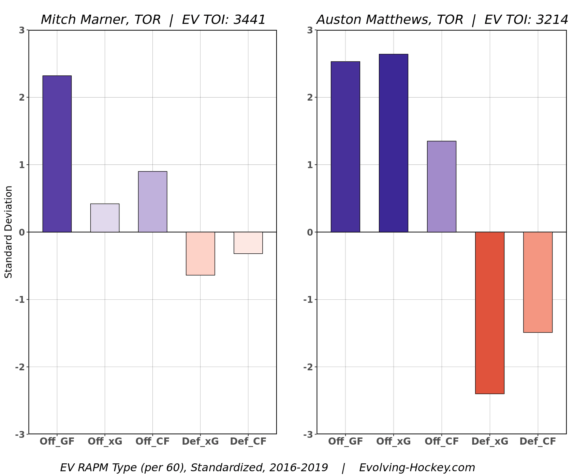
It is close, but Matthews has a bit of an edge over Marner because of his influence on offense. If Marner is expecting to earn $11.6 million, he may end up pricing himself out. And it may not come with the Leafs as they have only $3.7 million in cap space.
This is why the idea of signing him to an offer sheet has become a topic of discussion. There aren’t a lot of teams that can afford that cap hit, but the Devils are one. Does that mean they should do it? That’s for you to decide, but at 22 years old, he’s an emerging star winger.
Related: Mitch Marner Won’t Get Auston Matthews Money
It’s also far from a given he’d agree to sign with the organization. But if he did, he’d give them one of the best first lines in the NHL with Taylor Hall and Nico Hischier, so he’s worth considering, even if it means giving up four first-round picks.
Kyle Connor
Connor may not have the same name recognition as Marner and Laine, but he’s a great player in his own right. He’s improved in each of his three NHL seasons and finished with 34 goals and 66 points with 217 shots on goal in 2018-19. He’s coming off his entry-level contract (ELC), so he’s in need of a new deal.
Since the start 2017-18, he has a CF% of 48.84% and an xGF% of 48.65% to go along with a GAR of 14.2, the latter of which places him between Alex Kerfoot and Charlie Coyle. Connor’s five-on-five production has been quite good as he’s averaged 2.00 P/60. With that said, he’s primarily an offensive threat, and his defensive game could use work.
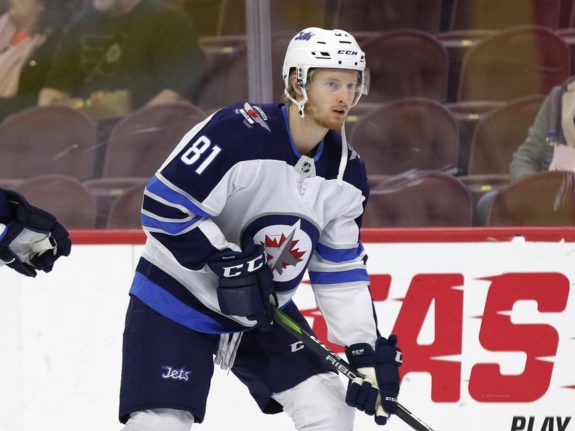
The Devils need a top-six left-wing, so that should put him on their radar. However, acquiring him via an offer sheet could prove difficult. His projected deal has a cap hit coming in over $6.8 million for six years. And that means needing to have your second-round pick.
If they’re that high on Connor, they’re more likely to get him through a trade. And that’s possible depending on what happens with the rest of their cap situation. The Jets aren’t even at the cap floor, but they have five RFAs to sign, including Connor and Laine. That means things could get tight in a hurry, so it’s a situation to keep an eye on.
Jakub Vrana
One of the more underrated RFAs who has yet to agree to terms is Vrana. He’s coming off his best season yet, with 24 goals and 47 points in 82 games with the Washington Capitals. Like Connor, he’s coming off his ELC and is due for a nice raise.
Vrana has been incredibly productive at five-on-five, averaging 2.00 P/60 over the last two seasons. His shot rates have been steady, too, as he has a CF% of 50.08% and xGF% of 50.65%. His GAR is 14.8 over that stretch, which is just a bit better than Connor’s. It’s fair to say he has the production of a second liner, but can the Capitals afford him?
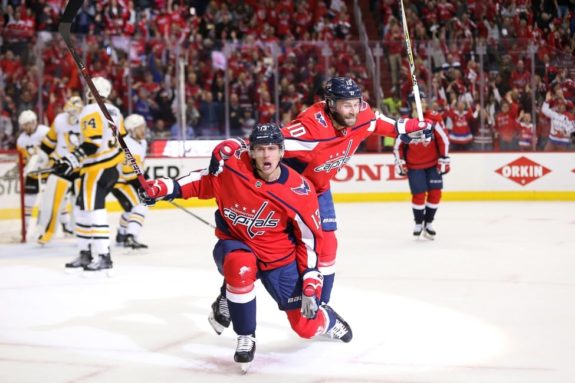
Their cap situation isn’t as dire as the Leafs, but they have only $4.285 million to re-sign Vrana as well as Christian Djoos and Chandler Stephenson, both of whom are RFAs. Braden Holtby is also an unrestricted free agent next summer, so that complicates matters even further.
Vrana is projected to get a bridge deal worth $3.1 million annually for two years. The Caps can give him that, but other teams can offer more, with one being the Devils. And they don’t necessarily need their second-round pick to do so. Let’s say they offer him a four or five-year agreement worth $4.25 million annually, the compensation would be a first and third-round pick, which isn’t over the top.
Related: Capitals’ Roster Can’t Fit Remaining RFAs
Like Connor, Vrana is a left-winger who fits in nicely as a second liner. He’s only 23 so giving up a first and third-round pick is worth it since you’d be getting him in his prime (the same can be said of a $4.25 million cap hit). It also gives the organization a chance to put a division rival in a bind. If Vrana’s looking for a long-term deal and can’t get one from the Capitals, he could consider other options. And that could be Shero’s chance to pounce.
Is an Offer Sheet Worth It?
It’s a pretty broad question, but it depends on a few things. First and foremost, you need to have a majority of your draft picks. Otherwise, trying to sign someone this way becomes close to impossible. You also need to have a fair amount of cap space. The Devils have both available to them, so it is an option worth considering.
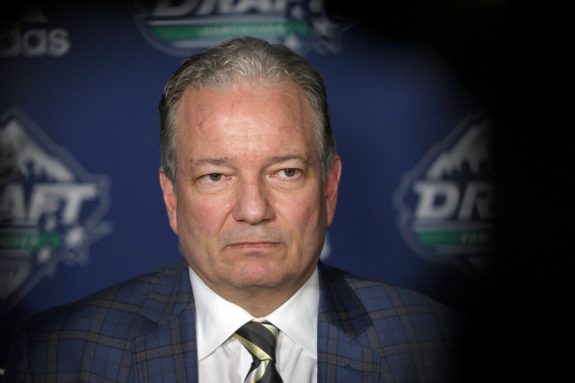
However, offer sheets are extremely rare, and teams tend to match them more often than not as was the case with the Hurricanes and Aho. They can also be extremely costly if you’re after a top player like Marner, which gives teams even further pause.
Time will tell if the Devils get in on the action. They are equipped to pursue one, however, and that’s especially true the longer these RFAs go unsigned. They need more talent, even after the additions of Subban and Wayne Simmonds. If the opportunity arises to add someone like Vrana or Marner, and it improves your team, then an offer sheet should always be considered an option to help strengthen your roster.
* * *
Advanced stats from Evolving Hockey, Natural Stat Trick